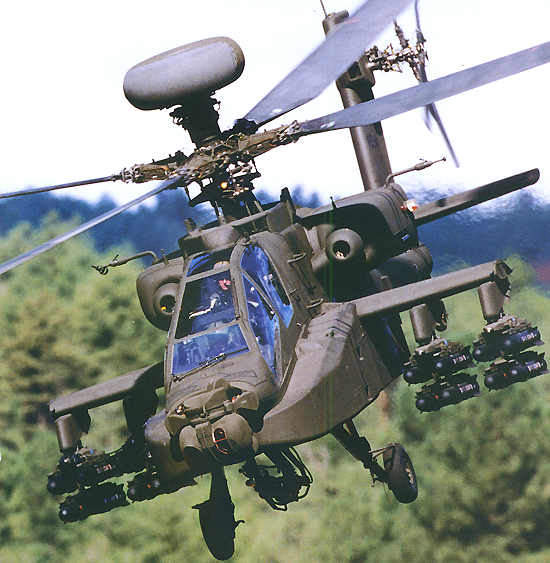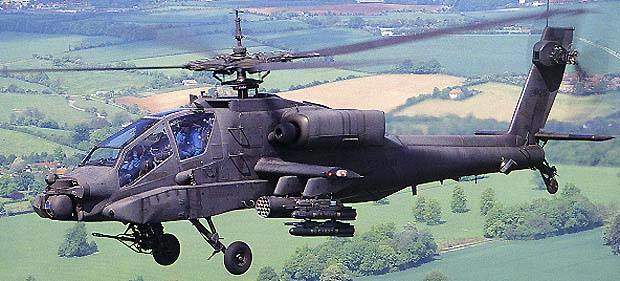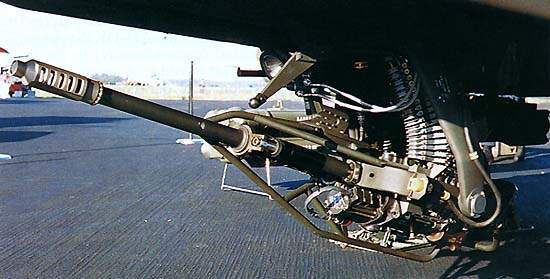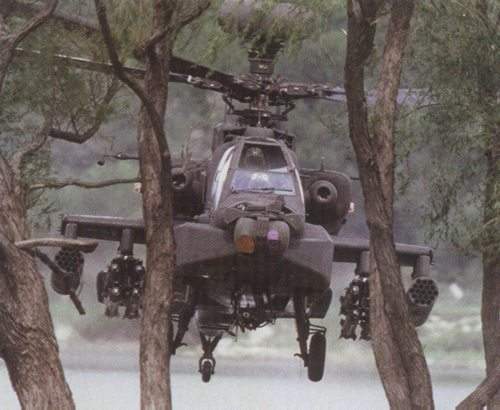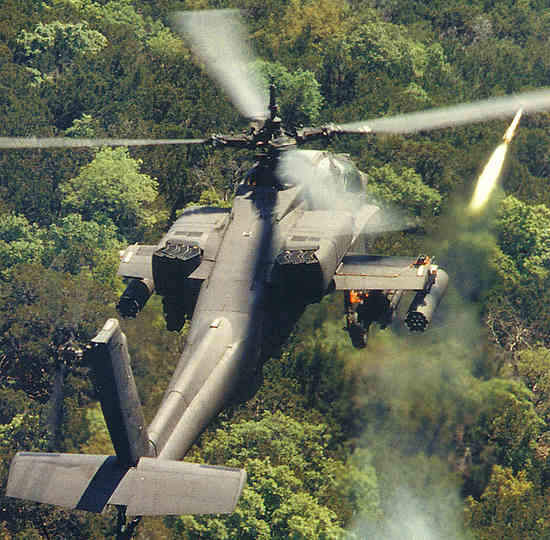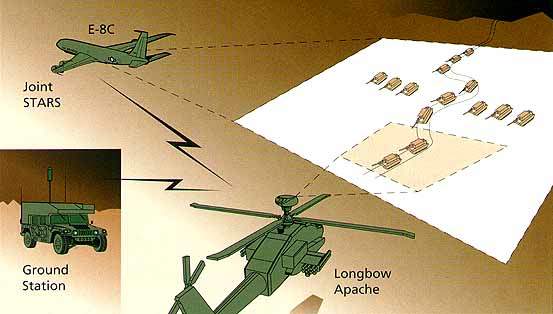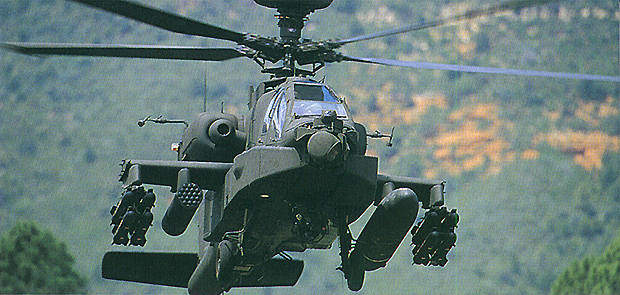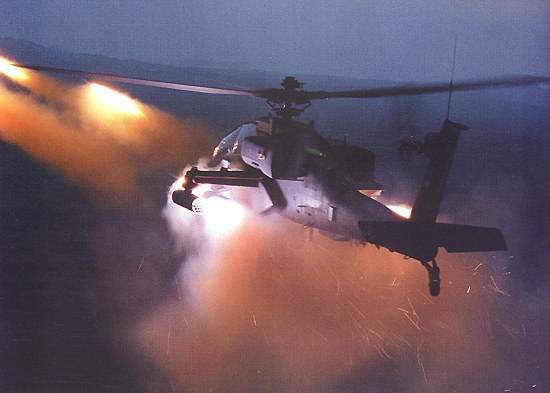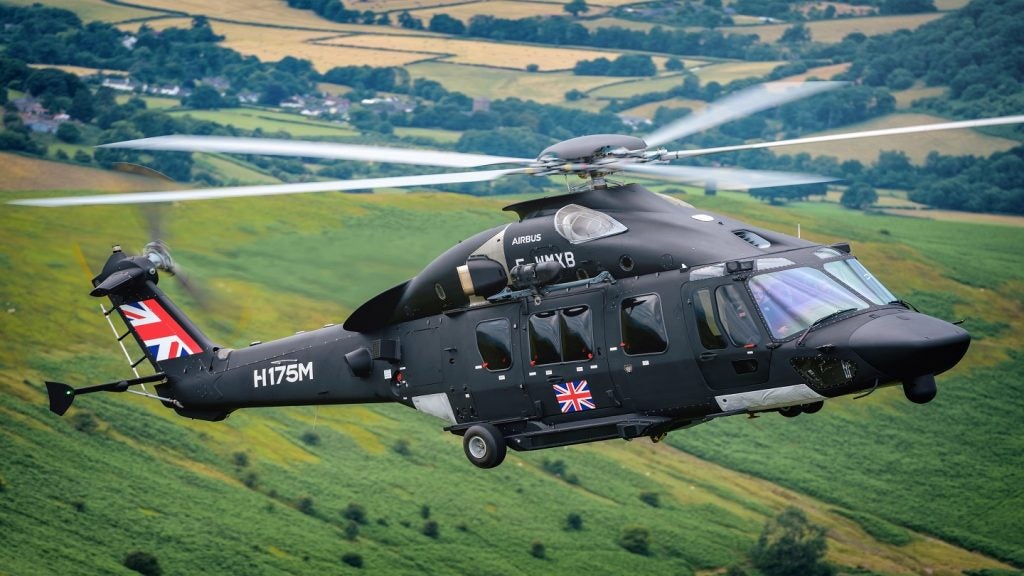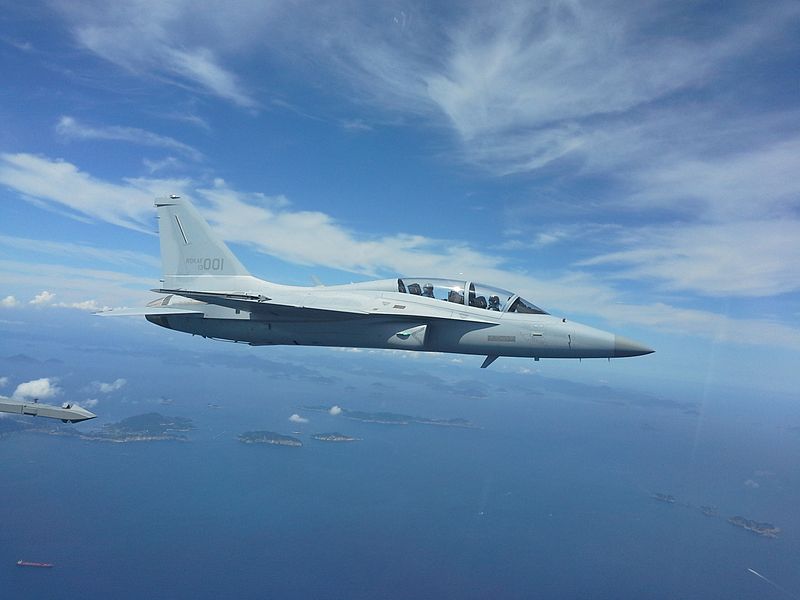
The Apache is a twin-engined army attack helicopter developed by McDonnell Douglas (now Boeing). It entered service with the US Army in 1984 and has been exported to Egypt, Greece, Israel, the Netherlands, Japan, Saudi Arabia, United Arab Emirates (UAE) and the UK.
The US Army has more than 800 Apaches in service, and more than 1,000 have been exported. The Apache was first used in combat in 1989 in the US military action in Panama. It was used in Operation Desert Storm and has supported low intensity and peacekeeping operations worldwide including Turkey, Bosnia and Kosovo.
The AH-64D Longbow was deployed by the US Army in Afghanistan as part of Operation Anaconda, in support of Operation Iraqi Freedom and, from June 2003, in South Korea.
The AH-64D Longbow is fitted with the Longbow millimetre wave fire control radar and the Longbow Hellfire missile. 501 AH-64A Apaches upgraded to AH-64D standard have been delivered to the US Army.
AH-64A/D Apache upgrades
The first of the upgraded block II Apaches was delivered to the US Army in February 2003. Block II included upgrades to the digital communications systems of 96 A-model Apaches to improve communications within the “tactical internet”. In October 2007, Boeing delivered the first extended block II to the US Army.
In July 2005, the US Army awarded Boeing a development contract for block III improvements, to enter service from 2011. In December 2009, the maiden flight test of AH-64D Apache with block III structures were completed.
Block III includes increasing digitisation, the joint tactical radio system, enhanced engines and drive systems, capability to control UAVs and new composite rotor blade. The new blades, which successfully completed flight testing in May 2004, increase the Apache’s cruise speed, climb rate and payload capability.
The block III system development and demonstration (SDD) contract was awarded to Boeing in July 2006. First flight of the Apache Block III was in July 2008. The US Army plans to upgrade all its Apache fleet to block III standard. Deliveries began in November 2011.
WAH-64 Longbow Apache helicopter
A consortium of GKN Westland (now AgustaWestland), Boeing, Lockheed Martin, Northrop Grumman and Shorts bid a version of the Longbow Apache for the UK Army attack helicopter requirement which was selected in July 1995. Assembly of the WAH-64 Longbow Apache was carried out in the UK by AgustaWestland.
The first helicopter entered service in January 2001 designated as the AH mk1. 67 helicopters have been delivered; the last was formally handed over at the Farnborough Air Show in July 2004.
Initial operating capability was achieved in October 2004 and, in May 2005, the first of three Army Air Corps regiments of 18 helicopters was declared fully operational. The other two regiments are expected were fully operational by 2010. The AH mk1 helicopter has also been operated successfully on HMS Ocean helicopter carrier and, in November 2006, made a first landing on Invincible Class aircraft carrier, HMS Ark Royal.
In March 2007, the UK Ministry of Defence announced that, by September 2007, all UK Army Apache helicopters would be based at Wattisham Airbase in Suffolk.
Apache weapons
A 30mm automatic Boeing M230 chain gun is located under the fuselage. It provides a rate of fire of 625 rounds a minute. The helicopter has capacity for up to 1,200 rounds of ammunition.
The AH-64D is armed with the Lockheed Martin / Boeing AGM-114D Longbow Hellfire air-to-surface missile which has a millimetre wave seeker which allows the missile to perform in full fire and forget mode. Range is 8km to 12km.
The Apache can be equipped with air-to-air missiles (Stinger, AIM-9 Sidewinder, Mistral and Sidearm) and the advanced precision kill weapon system (APKWS), formerly known as Hydra, family of guided and unguided 70mm rockets. Plans to arm the Apache with the advanced precision kill weapon system (APKWS) II, a laser-guided version of the Hydra were shelved in the FY2008 budget. The US Army awarded BAE Systems a development contract for the APKWS II in April 2006.
British Army AH mk1 helicopters are armed with the CRV7 70mm rocket system from Bristol Aerospace of Winnipeg, Manitoba.
The Longbow Apache carries the combination of armaments chosen for the particular mission. In the close support role, the helicopter carries 16 Hellfire missiles on four four-rail launchers and four air-to-air missiles.
Sensors
The AH-64D Longbow Apache is equipped with the Northrop Grumman millimetre-wave Longbow radar. The Longbow fire control radar incorporates an integrated radar frequency interferometer for passive location and identification of radar-emitting threats. An advantage of millimetre wave is that it performs under poor-visibility conditions and is less sensitive to ground clutter. The short wavelength allows a very narrow beamwidth, which is resistant to countermeasures.
The Longbow Apache can effect an attack in 30 seconds. The radar dome is unmasked for a single radar scan and then remasked. The processors determine the location, speed and direction of travel of a maximum of 256 targets.
The target acquisition designation sight, TADS (AN/ASQ-170), and the pilot night vision sensor, PNVS (AN/AAQ-11), were developed by Lockheed Martin. The turret-mounted TADS provides direct-view optics, television and three-fields-of-view forward-looking infrared (FLIR) to carry out search, detection and recognition, and Litton laser rangefinder / designator. PNVS consists of a FLIR in a rotating turret located on the nose above the TADS. The image from the PNVS is displayed in the monocular eyepiece of the Honeywell integrated helmet And display sighting system, IHADSS, worn by the pilot and copilot / gunner.
Lockheed Martin has developed a new targeting and night vision system for the Apache, using second-generation long-wave infrared sensors with improved range and resolution. The new system is called Arrowhead and has a targeting FLIR with three fields of view, a dual field-of-view pilotage FLIR, a CCD TV camera, electronic zoom, target tracker and auto-boresight. Arrowhead entered production in December 2003 and the first unit was delivered to the US Army in May 2005. 704 US Army Apaches are to be equipped with Arrowhead by 2011.
A contract to equip the UK AH Mk1 helicopters with Arrowhead was placed in May 2005. The first two were delivered in November 2008 and deliveries concluded in 2010.
Countermeasures
The Apache is equipped with an electronic warfare suite consisting of: AN/APR-39A(V) radar warning receiver from Northrop Grumman (formerly Litton) and Lockheed Martin; Lockheed Martin AN/APR-48A Radar Frequency Interferometer Electronic Support target acquisition system; AN/ALQ-144 infra-red countermeasures set from BAE Systems IEWS (formerly Sanders, a Lockheed Martin company); AN/AVR-2 laser warning receiver from Goodrich (formerly Hughes Danbury Optical Systems then Raytheon); AN/ALQ-136(V) radar jammer developed by ITT; and chaff dispensers.
US Army Longbow Apaches were to be fitted with the ITT AN/ALQ-211 SIRCM (suite of integrated radio frequency countermeasures) suite, however the availability of funding for this project is uncertain.
UK AH mk1 Apaches are fitted with BAE Systems helicopter integrated defensive aids suite (HIDAS), also chosen by Kuwait and Greece. HIDAS, which includes the Sky Guardian 2000 radar warning receiver, entered service on the AH mk1 in July 2003.
Israeli AH-64D helicopters are fitted with the Elisra Seraph self-protection system, including SPS-65 missile warner and SPJ-40 radar jammer.
Dutch AH-64D helicopters are being fitted with the Northrop Grumman directional infrared countermeasures (DIRCM) pod.
Engines
The Apache is equipped with two turboshaft engines, each providing 1,265kW. The American AH-64D has General Electric T700-GE-701 engines and the UK Apache is fitted with RTM322 engines from Rolls-Royce / Turbomeca.
Performance
The AH-64 Apache can climb at a rate of 889m/min. The maximum and cruise speeds of the helicopter are 279km/h and 260km/h respectively. The ferry range and service ceiling of the helicopter are 1,900km and 6,400m respectively. The endurance is 3 hours 9 minutes. The helicopter weighs around 5,165kg, while the maximum take-off weight is 10,433kg.
Apache helicopter international orders
The Longbow has also been ordered by the Netherlands (30, deliveries complete), Singapore (20, first delivered in May 2002, deliveries complete), Israel (designated “Seraph” nine new, nine remanufactured, first delivered April 2005) and Egypt (35, remanufactured, deliveries completed in January 2007).
A number of AH-64A helicopters have been upgraded to AH-64D standard for South Korea. 30 UAE Apaches are being upgraded to AH-64D Longbow standard, and deliveries began in May 2008. In June 2006, Saudi Arabia requested the upgrade of 12 Apaches to standard and, in September 2008, the sale of 12 new AH-64Ds. In October 2008, Taiwan requested the sale of 30 AH-64D Block III Apaches.
In August 2001, the AH-64D was selected by the Japanese Ground Self-Defence Force with a requirement for 55 helicopters. The Apache for Japan is designated AH-64DJP and is armed with Stinger air-to-air missiles.
In September 2002, Kuwait ordered 16 AH-64D helicopters. The first was delivered in February 2007. The Kuwaiti Apaches are equipped with BAE Systems HIDAS defensive aids system. In September 2003, Greece signed a contract for 12 (plus four options) AH-64D Longbow, also to be fitted with HIDAS. The first was delivered in January 2007.
In June 2011, Taiwan placed a $2.5bn order for 30 AH-64D Apache block III helicopters. The helicopters are scheduled to be delivered between 2012 and 2013.
The Global Military Rotorcraft Market 2011-2021
This project forms part of our recent analysis and forecasts of the global military rotorcraft market available from our business information platform Strategic Defence Intelligence. For more information click here or contact us: EMEA: +44 20 7936 6783; Americas: +1 415 439 4914; Asia Pacific: +61 2 9947 9709 or via email.

